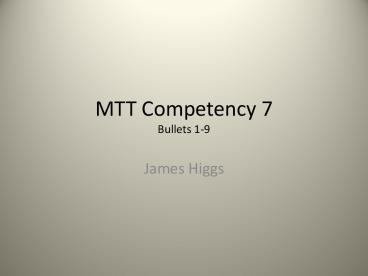MTT Competency 7 Bullets 1-9 - PowerPoint PPT Presentation
1 / 23
Title:
MTT Competency 7 Bullets 1-9
Description:
Inspirational projects based upon research of. history. people. life experiences ... Wiki that lets others add to work. How Do We Assess This? ... – PowerPoint PPT presentation
Number of Views:49
Avg rating:3.0/5.0
Title: MTT Competency 7 Bullets 1-9
1
MTT Competency 7Bullets 1-9
- James Higgs
2
MTT Competency 7
- The Master Technology Teacher demonstrates
knowledge of instructional design, development,
and assessment in a technology-enhanced
environment
3
Effective Instructional Design
- Knows components of effective instructional
design (e.g., eliciting and using prior
knowledge, synthesizing prior and new knowledge,
integrating knowledge and skills, applying
accessibility concepts, providing scaffolded
instruction, planning reviews) in a
technology-enhanced environment.
4
Effective Instruction Design Assessments
- Knows characteristics and uses of types of
technology-related assessments (e.g.,
performance-based, in-depth, continuous progress
monitoring, summative evaluation) and how to
facilitate the evaluation of students knowledge
and skills using technology-related assessment
methods.
5
Effective Instruction Design Assessments
- Knows how to use formal and informal assessments
to evaluate students technology proficiencies.
6
Effective Instruction Design Assessments
- Knows fundamental characteristics of quantitative
and qualitative assessments and understands how
to use these assessments appropriately to plan
and develop instruction.
7
Effective Instruction Design Assessments
- Demonstrates knowledge of fundamental
assessment-related issues, such as those related
to bias, reliability, and validity.
8
Effective Instruction Design Assessments
- Demonstrates knowledge of the benefits and
limitations of technology as applied to the
assessment process.
9
Effective Instruction Design Assessments
- Demonstrates knowledge of the reciprocal nature
of assessment, planning, and instruction.
10
Effective Instruction Design Assessments
- Knows how to facilitate ongoing student
self-assessment in the use of technology,
including both process and product.
11
Effective Instruction Design Assessments
- Demonstrates knowledge of appropriate
research-based strategies and instructional
methods for addressing the various technology
knowledge and skill levels of students.
12
Assessing Formally and Informally
13
Activities and Types of Assessment
- Historical Research
- archive search of newspapers,
- yearbooks and
- public records and
- online research through search engines etc.
- Assessment rubric to verify number, validity and
citing of sources
14
Activities and Types of Assessment
- 2. Oral History Recording
- recording of different school and community
members from diverse from age groups,
ethnicities and social-economic status - Assessment rubric to verify number, validity and
citing of sources - Quality of Recording
15
Activities and Types of Assessment
- 3. The creative process.
- Inspirational projects based upon research of
- history
- people
- life experiences
- historical time period research
- cultural background.
16
Activities and Types of Assessment
- The Creative Process
- Public Performance
- Peer Review
- Self Evaluation
- Blogging with chance to respond
- Wiki that lets others add to work
17
How Do We Assess This?
18
Sharing Activities as Type of Assessment
- 1. Public Performance
- 2. Public Presentation of PowerPoint
- 3. Publish on You Tube
- 4. Publish on School Website
- 5. Write a article about the research and submit
to local newspapers - 6. Create a Wiki with the research and allow
others to add to it
19
Sharing Activities Sharing Activities as Type of
Assessment
- 7. Create a blog with stories about developing
the ballad, the problems encountered, solutions
found, what the students individually learned,
how they feel about the project.
20
How Do We Give A Grade To This?
21
Assessments Matrix For Sharing Activities
- Public Performance - rubric on quality and
- enjoyability, academic standards,
appropriate technology - 2. Written Composition - assessed for validity,
originality, acadamic standards, appropriate
technology
22
Assessments
- 3. Digitized recordings - rubric on use of music
editing, appropiate text and voice editing,
available in at least 3 ways ex cd's, you tube,
pod cast, some type of downloads - 4. PowerPoint Presentation of research about
project- Content reliability, clarity of
presentation, enjoyably of presentation, depth of
work
23
Assessments
- 5. Photo Story Presentation - Rubric on the use
of software, use of background music, choice of
pictures, did it tell the story - 6. All rubrics will have 4 columns with 4 being
the best grade 4- meets all objectives, 3-almost
all objectives, 2-most objectives, 1-some
objectives































